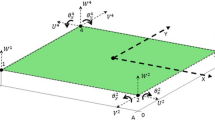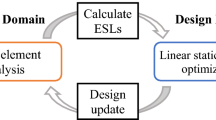Abstract
In this paper, a novel hybrid model reduction method is presented to simplify a complex, large-scale continuous-time system using the slime mould optimization algorithm (SMOA). The proposed method ensures the stability of reduced-order approximants as stability equations are incorporated along with the SMOA. It is also demonstrated that the stability claim of some of the existing model reduction methods is incorrect. An extensive comparative analysis of the dynamic responses and performance indices is also shown by using two case studies, confirming the supremacy of the presented method over the existing methods.










Similar content being viewed by others

Data Availability
Data sharing was not applicable to this article as no datasets were generated or analysed during the current study.
References
N. Ahamad, A. Sikander, A novel approach of order diminution using time moment concept with Routh array and Salp swarm algorithm. Turk. J. Electr. Eng. Comput. Sci. 29(2), 1077–1091 (2021)
S. Biradar, Y.V. Hote, S. Saxena, Reduced-order modeling of linear time invariant systems using big bang big crunch optimization and time moment matching method. Appl. Math. Model. 40(15–16), 7225–7244 (2016)
D. Butti, S.K. Mangipudi, S. Rayapudi, Model order reduction based power system stabilizer design using improved whale optimization algorithm. IETE J. Res. (2021). https://doi.org/10.1080/03772063.2021.1886875
T. Chen, C. Chang, K. Han, Reduction of transfer functions by the stability-equation method. J. Frankl. Inst. 308(4), 389–404 (1979)
A.K. Choudhary, S.K. Nagar, Order reduction techniques via Routh approximation: a critical survey. IETE J. Res. 65(3), 365–379 (2019)
A.K. Gupta, D. Kumar, P. Samuel, A meta-heuristic cuckoo search and eigen permutation approach for model order reduction. Sādhanā 43(5), 1–11 (2018)
A.K. Gupta, D. Kumar, P. Samuel, A mixed-method for order reduction of linear time invariant systems using big bang-big crunch and eigen spectrum algorithm. Int. J. Autom. Control 13(2), 158–175 (2019)
A.K. Gupta, D. Kumar, P. Samuel, Order reduction of linear time-invariant systems using eigen permutation and Jaya algorithm. Eng. Optim. 51(9), 1626–1643 (2019)
A.K. Gupta, C.N. Singh, D. Kumar, P. Samuel, Modified eigen permutation-based model simplification of LTI systems using evolutionary algorithm, in Intelligent Algorithms for Analysis and Control of Dynamical Systems, Springer, pp. 41–49 (2021)
S. Jain, Y.V. Hote, Order diminution of LTI systems using modified big bang big crunch algorithm and Pade approximation with fractional order controller design. Int. J. Control Autom. Syst. 19(6), 2105–2121 (2021)
A. Jazlan, V. Sreeram, R. Togneri, M. Bettayeb, Time weighted model reduction of flat plate solar collectors, in 2014 4th Australian Control Conference (AUCC), IEEE, pp. 107–111 (2014)
S. Li, H. Chen, M. Wang, A.A. Heidari, S. Mirjalili, Slime Mould algorithm: a new method for stochastic optimization. Futur. Gener. Comput. Syst. 111, 300–323 (2020)
S. Mirjalili, Sca: a sine cosine algorithm for solving optimization problems. Knowl. Based Syst. 96, 120–133 (2016)
S. Mirjalili, A.H. Gandomi, S.Z. Mirjalili, S. Saremi, H. Faris, S.M. Mirjalili, Salp swarm algorithm: a bio-inspired optimizer for engineering design problems. Adv. Eng. Softw. 114, 163–191 (2017)
S. Mirjalili, A. Lewis, The whale optimization algorithm. Adv. Eng. Softw. 95, 51–67 (2016)
S. Mirjalili, S.M. Mirjalili, A. Lewis, Grey wolf optimizer. Adv. Eng. Softw. 69, 46–61 (2014)
S.R. Potturu, R. Prasad, R. Meshram, Improved simplification technique for LTI systems using modified time moment matching method. Sādhanā 46(3), 1–11 (2021)
A.K. Prajapati, R. Prasad, A new model reduction method for the linear dynamic systems and its application for the design of compensator. Circuits Syst. Signal Process. 39, 1–21 (2019)
A.K. Prajapati, R. Prasad, Order reduction in linear dynamical systems by using improved balanced realization technique. Circuits Syst. Signal Process. 38(11), 5289–5303 (2019)
A.K. Prajapati, R. Prasad, Reduced-order modelling of LTI systems by using Routh approximation and factor division methods. Circuits Syst. Signal Process. 38(7), 3340–3355 (2019)
Y. Shamash, Stable reduced-order models using padé-type approximations. IEEE Trans. Autom. Control 19(5), 615–616 (1974)
Y. Shamash, Continued fraction methods for the reduction of constant-linear multivariable systems. Int. J. Syst. Sci. 7(7), 743–758 (1976)
A.A. Sikander, B.R. Prasad, A novel order reduction method using cuckoo search algorithm. IETE J. Res. 61(2), 83–90 (2015)
C.N. Singh, A.K. Gupta, D. Kumar, P. Samuel, Fuzzy c-means based model simplification using Jaya optimization algorithm, in 2018 2nd IEEE International Conference on Power Electronics, Intelligent Control and Energy Systems (ICPEICES), IEEE, pp. 881–885 (2018)
C.N. Singh, A.K. Gupta, D. Kumar, P. Samuel, Improved pole clustering based simplification of complex systems using big bang-big crunch optimization, in 2019 IEEE Students Conference on Engineering and Systems (SCES), IEEE, pp. 1–6 (2019)
C.N. Singh, A.K. Gupta, D. Kumar, P. Samuel, A mixed approach for model reduction using differential evolution and eigen permutation, in Intelligent Algorithms for Analysis and Control of Dynamical Systems, Springer, pp. 51–59 (2021)
C.N. Singh, D. Kumar, P. Samuel, Improved pole clustering-based LTI system reduction using a factor division algorithm. Int. J. Model. Simul. 39(1), 1–13 (2019)
B. Sonker, D. Kumar, P. Samuel, A modified two-degree of freedom-internal model control configuration for load frequency control of a single area power system. Turk. J. Electr. Eng. Comput. Sci. 25(6), 4624–4635 (2017)
B. Sonker, D. Kumar, P. Samuel, Dual loop IMC structure for load frequency control issue of multi-area multi-sources power systems. Int. J. Electr. Power Energy Syst. 112, 476–494 (2019)
V. Zakian, Simplification of linear time-invariant systems by moment approximants. Int. J. Control 18(3), 455–460 (1973)
Author information
Authors and Affiliations
Corresponding author
Additional information
Publisher's Note
Springer Nature remains neutral with regard to jurisdictional claims in published maps and institutional affiliations.
Rights and permissions
Springer Nature or its licensor holds exclusive rights to this article under a publishing agreement with the author(s) or other rightsholder(s); author self-archiving of the accepted manuscript version of this article is solely governed by the terms of such publishing agreement and applicable law.
About this article
Cite this article
Singh, C.N., Kumar, D., Samuel, P. et al. Slime Mould Optimization-Based Approximants of Large-Scale Linear-Time-Invariant Continuous-Time Systems with Assured Stability. Circuits Syst Signal Process 42, 1419–1437 (2023). https://doi.org/10.1007/s00034-022-02153-w
Received:
Revised:
Accepted:
Published:
Issue Date:
DOI: https://doi.org/10.1007/s00034-022-02153-w



